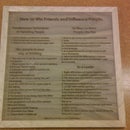Introduction: DIY Sous Vide
Sous Vide is a wonderful cooking technique to get the most out of your meats. However, actual off-the-shelf sous vide setups can run in the hundreds of dollars. Here's an alternative approach the uses an analog slow cooker, an aquarium controller, and a laser-cut plywood enclosure.
Full Discloser: I made it at Techshop and I highly recommend anyone near one to check them out.
Materials List:
1 Analog Slow Cooker: I used one I found on Amazon. The analog part is important because we're going to mess with the power.
1 PID Controller: Search for "Mini Digital Temperature Controller Thermostat Aquarium" on ebay and find one for around $16.00
1 sheet of 1/4" thick plywood: I used Create for Less
1 lightbulb socket adapter: I got one from Amazon
1 lightbulb socket: From Amazon
1 two prong power cord (I took mine from a broken appliance)
a small length of regular electrical wire
Step 1: Laser Cut the Encloser Pieces
Disclaimer, this step may seem optional, but what I've learned from experience is that working with a slow cooker means you're inevitably going to spill some water on whatever surface you're cooking on. If you have a bare PID controller (or worse, bare wires) anywhere around the area, you could put yourself in danger. I would highly recommend making at least some type of enclosure for your PID controller and to practice safe wiring techniques.
I have attached the three .ai files you'll need for the Epilog laser cutter (found at most Techshops). It's based on a 1:1 scale and is designed for 1/4" thick plywood and the exact controller I linked to on the previous page. If you are in any way going to deviate from the plan (and even if you aren't) I would highly advise going in and double checking thicknesses and clearances. Make it yours. Also, the hexagonal shapes on the layouts are not necessary, I just included them since two pieces couldn't fit in my original lasercutting stock. Feel free to disregard those.
Step 1: Follow all necessary procedures to setup your laser cutter
Step 2: Cut the stock
Step 3: Check fits
This is supposed to be a tight-fitting jigsaw puzzle, so definitely play around with it. The tolerances in my design were rather snug, so I chose to lightly sand some area, but for the most part was able to leave the design as it was.
Step 2: Assemble the Enclosure
Assembling everything is fairly straightforward. Give it a test fit before sanding everything down. Everything only has to go together once, with the exception of the top and bottom sliding covers. I ended up giving each cover about 1-2 minutes of sanding in order to be satisfied with the sliding tolerance.
Step 3: Wire Everything Up
Here is a high-level explanation of what is going on here.
The slow cooker has analog heaters built in and can be set to low, medium, or high. Now, imagine we've attached a light switch to the power cord. Setting the slow cooker to low is effectively the same as setting it to high and flipping the switch (power) on for short chunks of time. This is what the PID controller is doing. When the temperature sensor is below the desired temperature, the switch is closed (on) and the heaters are going as if there wasn't a controller attached. When the sensor reaches the desired temperature, the PID opens the circuit (turns it off) and the water is allowed to cool off until it reaches the minimum threshold again, at which point it closes the circuit (turns on), continuing the cycle. This is how the temperature is controlled.
The goal of this wiring setup is so that all you need to do is plug the Sous Vide Controller into the wall, and plug the slow cooker into the Sous Vide.
Since all we're doing is just interrupting a circuit, we're effectively only messing with one wire in the setup. This is seen in the series of pictures in this section. We have the power plug going into the input power terminals, but I've also wired it up to run one to the outlet adapter, and the other to the output power terminals. Then, I just have to run a wire from the output power terminal to the outlet adapter. Add the sensor in the middle, and you're good to go!
Note: I made a point of covering everything in shrink tubing for a reason. There are lots of wires close to one another and having them touch could ruin your controller, or worse. Please exercise proper practices and caution when wiring up your controller.
Note: One modification I made in this process was cutting off the rubber housing to the outlet adapter so there was just exposed metal, which is why it looks different from the Amazon picture.
Once you've got everything wired up, go ahead and just slide the PID controller into the front of your wooden enclosure. It will be a snug fit, so be gentle. Once it's in, pull the outlet adapter so the tabs are just inside the back edge of the panel. This is important because it will act as the only screw in the setup when you screw in the actual adapter. Screwing in the adapter causes the outlet's tabs to dig into the wood, allowing the back panel to be held shut.
Also, be sure to run the sensor wire out the top and the power cord out the bottom. You can make the lengths whatever length you desire, but I chose a 2' power cord and a 3 foot sensor wire.
Step 4: Ready to Cook
Now that everything is assembled, you're good to go!
Just plug the Sous Vide into the wall and the cooker into the Sous Vide. Follow the guide in the user manual that came with the controller to set the temperature, and be prepared to cook some delicious meals.
http://www.sousvidecooking.org/ is a solid resource for getting started and also for the serious Sous Vide chef.














